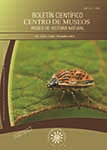Authors
Abstract
The structure and arboreal composition of a high Andean forest in the Colombian Central mountain range, which is located in the Caldas department at an altitude of 3,100 m, was characterized. Such ecosystem has been reduced and simplified due to the expansion of potato crops and livestock activities. The dynamics and arboreal composition of a 0.1 ha, transect is described using five 50 x 4m plots , where all of the individuals with a DAP > 1.5cm were accounted for, stem and total height. One hundred-three individuals were registered, belonging to 42 species and morph-species, distributed in 40 genera and 34 botanical families. Weinmannia pubescens and Hedyosmum bonplandianum were the species with greatest ecological importance (40.9% and 26.7%, respectively). The families with the higher IVF were Rubiaceae 40,4%, Cunoniaceae 37,2%, Podocarpaceae 27,5% y Melastomataceae 23,1% The interval between 7.8 – 10 m height had the highest species count. The total basal area was 2.88m2 from which 22.7% were represented by Weinmannia pubescens. Despite the human intervention history and the frequency of young arboreal individuals, it was observed the presence of tree species characteristic of an advanced succession status, which also present a high risk of extinction, due to their commercial value (e.g. Podocarpus oleifolius, Prumnopitys montana, Rhodostemonodaphne laxa and Turpina occidentalis). Therefore it becomes necessary to develop ecological restoration programs with native species that allow the conservation of these resources and the constant provision of environmental goods and services in the region.
Keywords:
References
ALVEAR, M. 2000. Flora y vegetación de la Reserva Torre IV (Manizales, Colombia): Tesis, Universidad Nacional de Colombia, Facultad de Ciencias. Bogotá.
ALVEAR, M., BETANCUR, J., FRANCO-ROSSELLI, P., 2010. Diversidad florística y estructura de remanentes de bosque andino en la zona de amortiguación del Parque Nacional Natural los Nevados, Cordillera Central Colombiana. Caldasia., 32(1): 40-41.
APG., 2009. Angiosperm Phylogeny Website, Missouri Botanical Garden. Sep. 2011.
COGOLLO, A., VELASQUEZ-RUA, J.,L. TORO & N. GARCIA. 2007. Las podocarpáceas: 193-224 (en) GARCIA, N. (ed) Libro Rojo de Plantas de Colombia. Vol. 5. Bogotá.
CUATRECASAS, J., 1958. Aspectos naturales de la vegetación de Colombia. Revista Académica Colombiana de Ciencias Exactas y Naturales, 10(40): 221–268.
DUEÑAS-C, A., BETANCUR, J., GALINDO-T, R., 2007. Estructura y composición florística de un bosque húmedo tropical del parque nacional natural Catatumbo Barí, Colombia. Revista Colombiana Forestal. 20(10): 26-39.
FINOL, H., 1976. Estudio fitosociológico de las unidades 2 y 3 de la Reserva Forestal de Carapo, Estado de Barinas. Acta Botánica Venezuelica 10 (1-4): 15-103.
FORERO, E. & MORI, S., 1995. The organization for Flora Neotropica. Brittonia, 47: 379-393.
FRANCO-ROSSELLI, P., BETANCUR, J., FERNÁNDEZ–ALONSO, J.L., 1997. Diversidad florística en dos bosques subandinos del sur de Colombia. Caldasia. 19(1-2): 206–207.
GALEANO, G., 2001. Estructura, riqueza y composición de plantas leñosas en el golfo de Tribugá, Chocó, Colombia. Caldasia 23 (1): 213-236.
GALEANO, G & R.BERNAL., 2005. Palmas: 59-224 (en) CALDERON, E., G. GALEANO & N. GARCIA (eds.) Libro rojo de Plantas de Colombia. Vol. 2. Bogotá.
GALINDO–T, R., BETANCUR, J., CADENA–M, J., 2003. Estructura y composición florística de cuatro bosques andinos del santuario de flora y fauna Guanentá- Alto Río Fonce, cordillera Central Colombiana. Caldasia 25(2): 313–335.
GENTRY, A. H. 1982. "Patterns of neotropical plant diversity". En: Evolutionary Biology, 15: pp. 1-84.
GENTRY, A. H. 1993. A field guide to the families and genera of woody plants of northwest South America. Washington: conservation international. pp. 895.
GENTRY, A. H., 1995. Patterns of diversity and floristic composition in neotropical montane forest. En: CHURCHILL, S.; BALSLEV, H.; FORERO, E. & LUTEYN, J. (eds.) Biodiversity and Conservation of Neotropical Montane Forest. The New York Botanical Garden. New York.103-126.
GIRALDO–CAÑAS, D., 2001. Análisis florístico y fitogeográfico de un bosque secundario pluvial Andino, cordillera Central (Antioquia, Colombia). Darwiniana 39(3-4): 187-199.
HALL, J., ASHTON, M.S., GAREN, E.J. JOSE, S. 2011. The ecology and ecosystem services of native trees: Implication for reforestation and land restoration in Mesoamerica. Forest Ecology and Management 261: 1553–1557.
IPNI., 2009. The International Plant Names Index. KEW, The Royal Botanical Garden, The Harvard University Herbarium & Australian National Herbarium. Sep. 2011.
MARÍN-CORBA, C. A & BETANCUR, J., 1997. Estudio florístico de un robledal del santuario de flora y fauna de Iguaque (Boyacá, Colombia). Revista Académica Colombiana de Ciencias, 21(80): 249–259.
MENDOZA, H., 1999. Estructura y riqueza florística del bosque seco tropical en la región Caribe y el Valle del Río Magdalena, Colombia. Caldasia. 21(1): 79-94.
MYERS, N., MITTERMEIER, R. A., MITTERMEIER, C. G., DA FONSECA, G. A. B. Y KENT, J. 2000. Biodiversity hotspots for conservation priorities. Nature 403: 853-858.
OLSON, D. M. & E. DINERSTEIN., 1997. Global 2000: Conserving the word's distinctive ecoregions. USA. WWF–US.
RANGEL, O. J, & VELÁSQUEZ, A., 1997. Métodos de estudio de la vegetación: 61-62 (en): RANGEL, O.J., LOWY, P.D., AGUILAR, M. Colombia diversidad biotica II. Guadalupe. Santa de Bogotá.
RANGEL-CH. J.O. 2000. La biodiversidad en la región del páramo: con especial referencia a Colombia. Universidad Nacional de Colombia–Instituto Alexander von Humboldt. Ed.Unilibros.
SANÍN, D. & DUQUE, C. 2006. Estructura y composición florística de dos transectos localizados en la reserva forestal protectora de Río Blanco (Manizales, Caldas, Colombia). Bol. Cient. Mus. Hist. Nat. U. de Caldas 10: 47–48.
SMITH A. R.; K. M. PRYER; E. SCHUETTPELZ; P. KORALL; H. SCHNEIDER & P. WOLF., 2006. A classification for extant ferns. Taxon 55(3): 705-731.
SAMSON D. A. & K. S. WERK., 1986. Size-dependent effects in the análisis of reproductive effort in plants. The American Naturalist 127: 667–679.
TORRES-ROMERO, J., 1988. Podocarpaceae. Flora de Colombia. Monografía No. 5:75
VAN der HAMMEN T. & A. M. CLEEF., 1983. Datos para la Historia de la Flora Andina. Revista Chilena de Historia Natural. 56: 97–107.
W3TROPICOS, 2010. Nomenclatural Data Base of Missouri Botanical Garden. Sep. 2011

 PDF (Español)
PDF (Español)
 FLIP
FLIP















